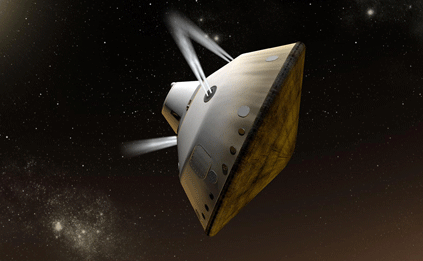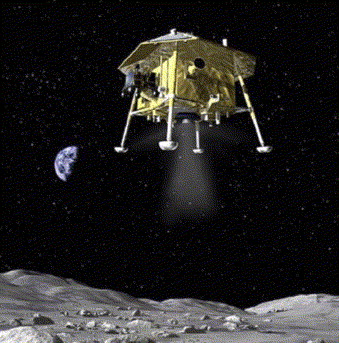
Deep Space Solid Propellant Ignites In Vacuum
WSPC is developing a generic space motor that couples a new WSPC solid propellant that is designed for use in deep Space applications with a new variable area throat nozzle. This new propellant can be ignited under hard vacuum conditions and sustains combustion under vacuum conditions. It has a high burn rate compared to standard Space booster composite propellants. The burn rate of the propellant is also relatively unaffected by extreme cold temperatures. A deep Space solid propellant combined with a motor that can throttled would have applications for planetary and lunar landers.
Today’s composite solid rocket propellants require a minimum chamber pressure or they will stop burning. This pressure is usually around 5 psia. That means an igniter for a motor in Space must pressurize the chamber above this pressure in addition to igniting the propellant grain or the propellant will not ignite. WSPC’s new composite propellant eliminates this problem since it will ignite in a hard vacuum. It has been ignited in a vacuum as low as 2 microns of Hg.


A second problem with current solid rocket propellants is that their burn rate dramatically slows down as they get cold. This makes their use in Space difficult as the cold temperatures of Space reduce the burn rate to levels where their thrust output becomes of limited use. WSPC’s new deep Space propellant does not exhibit the sensitivity to extreme cold that current solid rocket propellants show. WSPC has burned this propellant at temperatures as low as -109F with no significant effect on its burn rate.
A unique feature of this new propellant is its high burn rate for a simple composite propellant. While current solid propellants increase their burn rate at the expensive of shock sensitivity or the use of explosive ingredients, WSPC’s new propellant uses standard oxidizer and metal particles sizes and no explosive ingredients. Instead, the burn rate is increased by the use of a new binder that is non-explosive, yet significantly increases the burn rate. WSPC tests have shown the burn rate to be over an inch per second at 1,000 psi.
Deep Space Solid Propellant In "Real Time" Variable Thrust Motors
WSPC has also been developing and testing a new variable area throat rocket nozzle. This new nozzle can handle “cool” burning ammonium nitrate propellants and the “hottest” ammonium perchlorate propellants as well. Unlike pintle nozzles, none of the nozzle mechanism consumes space inside the chamber that can be better filled with propellant. Unlike other variable throat area nozzles, it can be run off a 9v dc battery. Its low electrical power demand, ability to handle “hot” propellants, and not take up space inside the chamber make it ideal for deep space missions.
WSPC has combined this new nozzle with their new deep space propellant to create a new solid rocket motor that has capabilities never seen before. A solid rocket motor that can sit for years in the cold, vacuum of Space before it is needed and still ignite reliably. Once ignited, the motor can provide real-time throttable thrust for landing missions or course-changing maneuvers.
